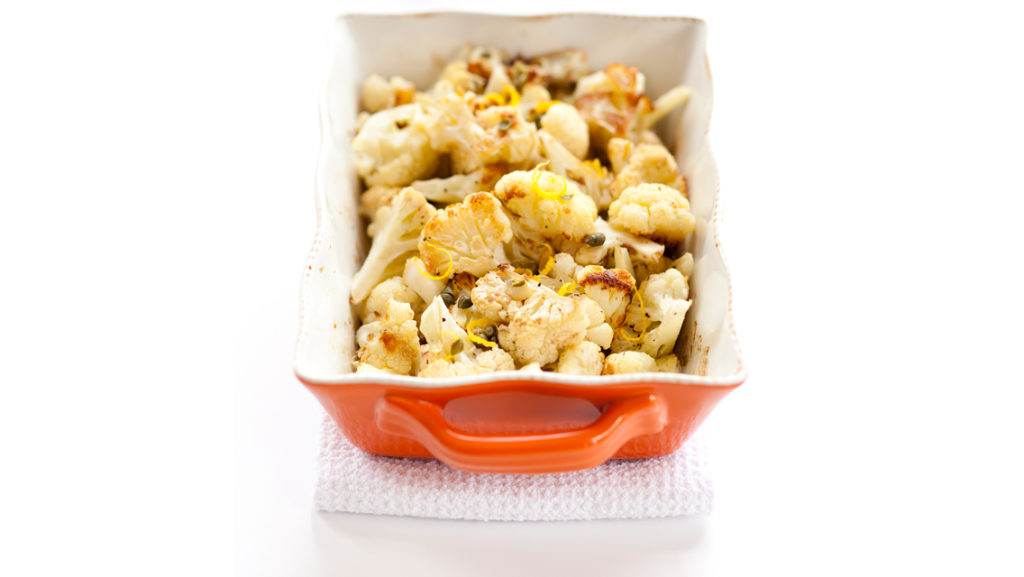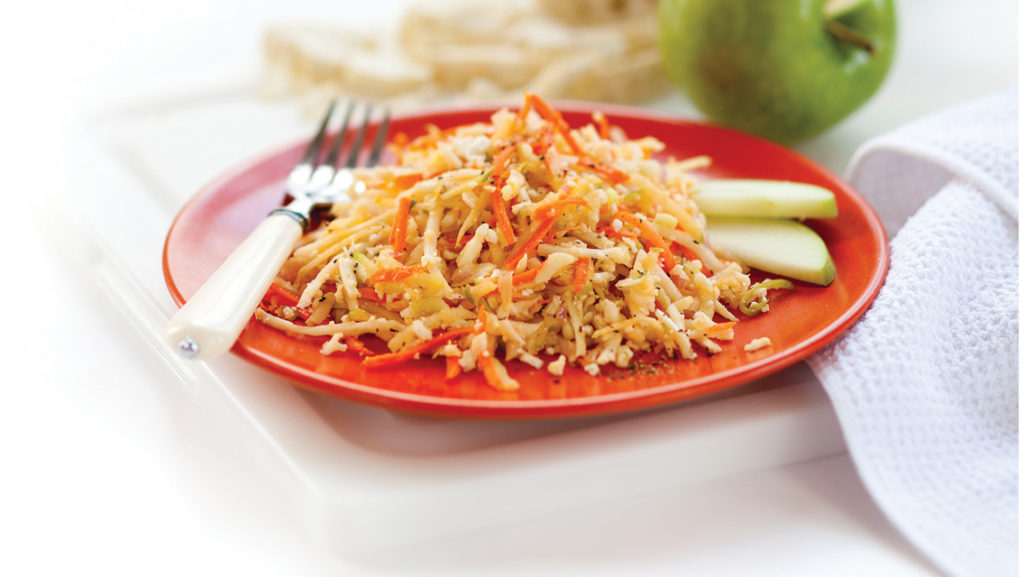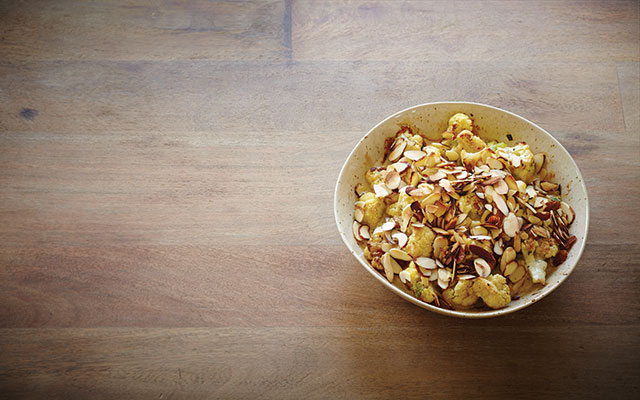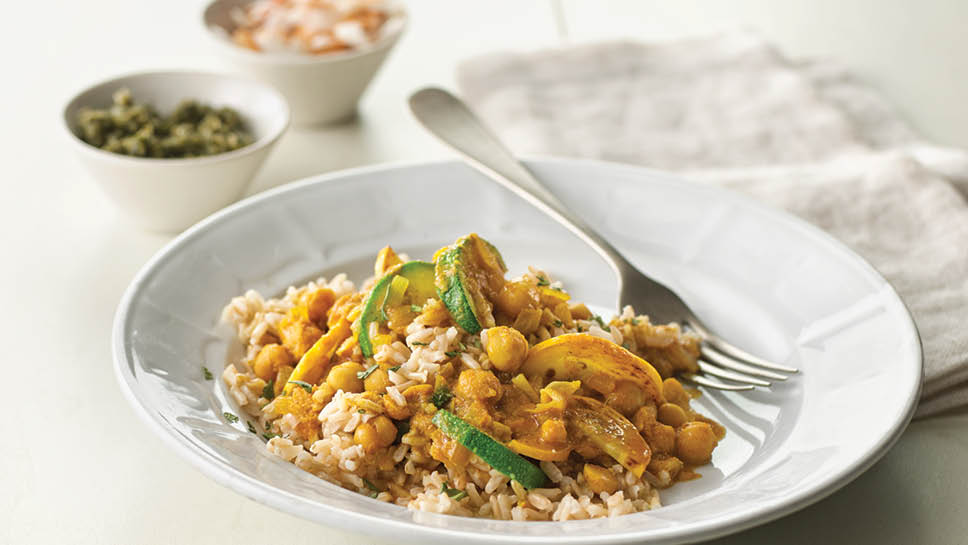Cauliflower is one of those vegetables that people have long underestimated. Even Mark Twain couldn’t resist dissing it: “Cauliflower is nothing but cabbage with a college education,” he once said. Twain was right about one thing: Cauliflower is a member of the cabbage family. But as for that college education — it’s more like a graduate degree in nutrition.
A cruciferous vegetable, cauliflower is loaded with vitamins, minerals, phytonutrients, antioxidants and fiber. Dozens of studies link diets rich in cauliflower to lowered risks of cancer. Because cauliflower has such a subtle, low-key flavor, though, boring veggies-and-dip plates don’t really do it justice. Instead, it pairs beautifully with bolder spices, like turmeric, ginger and fennel seed. Read on to learn more about cauliflower’s strengths. Once you know how to make the most of them, you’ll never take cauliflower for granted again.
Nutrition Know-How
- Cruciferous vegetables — such as cauliflower, kale, broccoli and cabbage — are important for cancer prevention because they provide powerful antioxidants and anti-inflammatory nutrients, and they help detoxify the body. Eat two to five servings a week to leverage these benefits.
- Cauliflower’s anti-inflammatory properties come in part from omega-3 fatty acids (in the form of alpha-linolenic acids, or ALA); high levels of vitamin K, which is also good for strong bones and helping blood to clot; and glucosinolates, which the body converts into an anti-inflammatory compound called indole-3-carbinol, or I3C.
- Cauliflower is a fantastic source of vitamin C, a powerful antioxidant; 1 cup steamed provides about 90 percent of the recommended daily amount. It is also an excellent source of folate and fiber.
Kitchen Tricks
- To preserve cauliflower, don’t wash it until you’re going to use it.
- Cauliflower is great raw, and best paired with bold-flavored complements (hummus, chili-spiced yogurt, etc.). It’s also nice in slaws.
- The stems and core are edible, too. When preparing them for cooking, cut the so that they’re about the same size as the florets.
- When steaming cauliflower, add a tablespoon of lemon juice to the water to keep the cauliflower from discoloring.
Shopping and Storage Tips
- Look for a firm, compact center “curd,” preferably surrounded by thick green leaves.
- Avoid cauliflower that is spotted, dull in color, or has small flowers starting to appear.
- The size of the cauliflower doesn’t affect taste or texture, so buy according to how much you need.
- Store-bought, precut florets should be eaten within one to two days. Whole heads can be stored unwashed for up to five days in the refrigerator. To prevent excess moisture from forming, place cauliflower stem-side down in a paper bag or a reusable perforated storage bag. If you can’t use up all the cauliflower within five days, steam and freeze it — or pickle it. (See the “Quick and Easy” section below for a quick refrigerator pickle recipe.)
Choose Your Hue
Classic, white cauliflower is the most common variety of this cruciferous vegetable. But cauliflower comes in a variety of colors with subtle flavor differences. Use them interchangeably to make your meals more nutritious and beautiful.
Purple. Purple cauliflower cooks a little faster than white and has a slightly milder flavor. Its color comes from anthocyanins, the same cancer-fighting phytonutrients found in beets, blueberries and raisins. It’s also a little higher in vision-helping vitamin A than white cauliflower.
Orange. Orange cauliflower tastes a little sweeter, milder and creamier than its white counterpart. But, it cooks much the same as white cauliflower. The biggest difference? Orange cauliflower has about 25 percent more beta-carotene.
Green. A cross between cauliflower and broccoli, it’s sometimes called broccoflower. And, when cooked it tastes a bit more like broccoli. Romanesco is a type of broccoflower that grows in a beautiful spiky variation. It can be prepared just like a regular cauliflower.
Quick and Easy
1. Steam. First trim off the thick leaves and (if you’re steaming the whole head) cut an “x” into the bottom of the core. Place the cauliflower into a steamer and cook until tender. For a pretty presentation, cut into wedges, place on a plate and serve with extra-virgin olive oil and lemon wedges. Or, toss with a jarred simmer sauce and season as desired.
2. Roast. For a quick side, roast coarsely chopped cauliflower (stems and all) with extra-virgin olive oil, salt and pepper. Place in the oven for 30 to 35 minutes at 400 degrees F. For the best, most caramelized flavor, allow the cauliflower to turn golden brown on the edges, but avoid burning.
3. Purée. Enjoy cauliflower as a more nutritious (and lower-glycemic-index) alternative to mashed potatoes. After steaming or roasting, just mash or purée cooked cauliflower and season like mashed potatoes, with butter, salt and pepper. A little grated sharp cheddar or Pecorino Romano cheese on top adds a salty, nutty bite.
4. Grill. Slice cauliflower crosswise into 1/2-inch slices and brush with extra-virgin olive oil; sprinkle with a little salt and grill until tender. Top with fresh ground black pepper and chopped fresh rosemary.
5. Pickle. To make the brine, simmer 2 cups rice wine vinegar, 1/4 cup honey, 1 cup water and 2 tablespoons kosher salt together with 1 tablespoon whole coriander seeds, five slices of fresh gingerroot, five crushed garlic cloves and a Thai chili until salt dissolves. Pour brine over 2 cups cauliflower florets, 1/4 cup sliced red onion and 1 cup sliced red radishes; refrigerate overnight. Not a fan of pink? Substitute white onion and white daikon radish for the red veggies. Either way, your pickled cauliflower will keep two weeks.
Recipes
Roasted Cauliflower, Anchovies, Capers and Garlic
This side can be enjoyed on its own or tossed with pasta or gnocchi. If you don’t care for anchovies, substitute minced Kalamata olives. Just know that the anchovies dissolve in the sauce when cooked and don’t taste fishy. Because anchovies have plenty of salt, there is no need to add more to your roasting cauliflower.

Makes | 6 servings
Ingredients
- 2 tbs. olive oil, divided
- 4 cups chopped cauliflower, with flower cut into florets and stems cut into 1-inch by 1-inch pieces
- 8 anchovy fillets, minced
- 3 cloves garlic, crushed into 1 tbs. olive oil
- 1 tbs. small capers
- Zest and juice of one lemon
- Freshly ground black pepper
Directions
- Preheat oven to 400 degrees F.
- Drizzle baking sheet with 1 tablespoon olive oil and toss the chopped cauliflower with it. Roast for 30 to 35 minutes, stirring two to three times, until softened and golden.
- When cauliflower is roasted, heat a small sauté pan with 1 tablespoon olive oil, and add the anchovies and garlic in olive oil. Sauté for about 15 seconds, stirring regularly.
- Add the capers, lemon zest and lemon juice, and black pepper, and remove from heat. Stir until mixed and pour over the cauliflower, tossing slightly to combine.
- Serve warm or at room temperature.
Creamy Carrot and Cauliflower Soup
This puréed soup is smooth, creamy and dairy free. If you want a white soup, substitute parsnips for the carrots. If you want to intensify the soup’s color, use orange cauliflower.

Makes | 4 servings
Ingredients
- 1 tbs. unsalted butter
- 1 cup diced yellow onion
- 1 stalk celery, diced
- 2 tbs. minced fresh gingerroot
- 2 medium carrots, peeled and diced
- 3 cups chopped cauliflower
- ½ cup raw cashew pieces
- 4 cups chicken stock
- ½ tsp. ground cardamom
- Salt and fresh ground pepper, to taste
- Crumbled goat cheese and toasted pumpkin seeds, if desired
Directions
- Melt butter in a medium saucepan. Add onion, celery and ginger, and sauté until vegetables are softened, about five minutes.
- Add carrot, cauliflower and cashews, and sprinkle with a little salt to “sweat” the vegetables. Cover and cook, stirring every few minutes, for about 10 minutes.
- Add the chicken stock, cover and simmer until vegetables are very tender.
- Purée the soup with an immersion or regular blender. (If you’re using a regular blender, fill it only one-third or halfway, and cover lid with a kitchen towel to prevent the soup from bursting out.)
- Season with salt, pepper and cardamom. Sprinkle with goat cheese crumbles and toasted pumpkin seeds before serving.
Cauli-Slaw
This slaw can be made even more colorful by using purple or green cauliflower, and by substituting red apples for the green, or adding red cabbage into the mix. Sprinkle in some currants for more texture and flavor. Although a food processor with a grater attachment is helpful for preparing vegetables for this salad, you can use a hand grater or finely chop the vegetables by hand.

Makes | 6 servings
Directions
- 4 cups shredded cauliflower, stems and core included
- 1/2 cup finely minced red onion
- 2 medium carrots, peeled and grated, (about 1½ cups)
- 1 Granny Smith apple, cored, quartered and grated
- Zest of one lemon
- Juice of one lemon, about 1/4 cup
- 1/3 cup extra-virgin olive oil
- 1/2 tsp. salt
- Freshly ground black pepper
Ingredients
- Mix vegetables together in a bowl.
- Whisk the lemon zest and juice with the olive oil, and add salt and pepper.
- Toss with the veggies and chill before serving.
Aloo Gobi
A classic Indian dish of cauliflower and potatoes, Aloo Gobi has a complex base of spices and tomatoes. The turmeric gives the cauliflower a lovely yellow color and has many health benefits, including anti-inflammatory properties. Serve with a cooling spinach raita or add shredded kale to the dish to get your greens.

Makes | 6 servings
Ingredients
- 2 tbs. coconut oil or ghee
- 1 large onion, diced
- 1 or 2 jalapeños, minced
- 2 tbs. minced fresh ginger root or coarsely grated
- 4 cloves minced garlic
- 2 tsp. cumin seeds
- 2 tsp. turmeric
- 2 tsp. ground coriander
- 2 cups diced tomatoes, fresh or canned, with juices included
- 3 cups cauliflower florets
- 6 Yukon gold potatoes (about 3 cups peeled and cubed)
- 1/2 cup chopped fresh cilantro
Directions
- Heat coconut oil or ghee in a large Dutch oven or heavy saucepan. Sauté the onion, jalapenos, ginger, garlic, and cumin seeds together over medium heat until softened. Turn heat to low if the vegetables begin to brown too quickly.
- After five to seven minutes add turmeric and coriander. Sauté for two minutes to develop the flavor of the spices then add tomatoes.
- Cook for five minutes, stirring well until mixture resembles a paste. Increase heat to medium and add cauliflower and potatoes. Stir well to coat with the curry mixture.
- Cover to cook, stirring every couple of minutes, making sure the heat isn’t too high that the curry will scorch. Cook until cauliflower and potatoes are tender, then remove from heat.
- Add salt to taste and gently stir in the chopped cilantro.
A Cauliflower of Another Color
After more than 25 years in the produce business — working his way up from being a grocery-store manager to an executive at the corporate offices of Chiquita, Green Giant and Wild Oats — Doug Ranno decided he’d had enough of mass-produced veggies. “At the time, I was the vice-president of produce for Wild Oats in Boulder, Colo.,” says Ranno, “and I thought, ‘Wouldn’t it be great to start a business whose principal purpose is to grow for color, taste and nutrition — as opposed to maximum production?’”
After researching colorful heirloom vegetables, Ranno discovered that they often contain higher levels of vitamins and phytonutrients, andthat kids love them. So in 2003 he founded the Salinas, Calif.–based Colorful Harvest, a company that sources heirloom seeds and uses traditional plant-to-plant breeding techniques to produce brilliantly hued and highly nutritious vegetables.
In addition to red sweet corn, purple artichokes, violet broccoli and five colors of carrots, the company also produces orange, purple and green cauliflower (as well as the traditional white). Colorful Harvest distributes its produce nationally to grocery stores, restaurants and school cafeterias. We talked to Ranno about what makes his tricolor cauliflower so distinctive, and about his personal passion for promoting unusual veggies.
What was your biggest inspiration in developing and promoting these unusual vegetables?
Right after I founded Colorful Harvest, we discovered that my daughter had serious food allergies that were also triggering both eczema and asthma. When she would eat the wrong types of food, including certain types of vegetables, her immune system would go haywire and she would end up in the hospital with a respiratory infection. So, that kind of pushed me even more to get real passionate about growing some of these different vegetables, like yellow carrots and red corn, to which she wouldn’t be allergic. There are many people out there like my daughter, who can’t eat certain items because of food allergies, and these vegetables can help them get the diversity of nutrition they need. For example, somebody who is allergic to carrots can get beta-carotene from an orange cauliflower. And, a big bonus is that my son and a lot of other kids really enjoy them, too. The colors make the vegetables fun to eat — and you don’t have to introduce anything artificial.
Why would a nonallergic person be interested in a brightly colored cauliflower?
From a creativity standpoint, both chefs and eaters enjoy the variety of different colors and flavors. As noted, you also get a wider diversity of nutritional benefits. But, ultimately, they are just really fun to experiment with.
Do purple, green and orange cauliflowers taste different from the conventional white kind?
People say they taste better because they are from older-style seeds. The green cauliflower tastes a little bit more like broccoli. In general, the colorful varieties of cauliflower have less of a cruciferous aftertaste, and you don’t notice the smell quite as much when you cook them.




This Post Has 0 Comments